Wine lovers, historians and long-time readers of Vintage Tastings know of Bipin Desai. When it comes to the great American collectors of all-time, he is without question near or at the top of the charts. Not many people can casually say how they have had ’61 Palmer over 100 times, for starters. But Bipin’s love of wine has gone far beyond personal enjoyment; he has conducted some of the greatest wine events the public has ever seen. When it comes to his closest of friends, there is the Royal Order of the Purple Palate.
The ROPP has been meeting monthly for longer than I have been selling wine, and that’s longer than you may think. Every month a different member hosts a meal at one of LA’s top restaurants and provides the wines as well. All wines are served blind according to a theme, or a clue. And so the games begin.
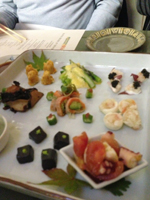
The Beginning
This particular month was hosted by the X-Man. I am not sure if the X-Man is part mutant, but he is definitely part wine super hero. He appropriately hosted his dinner at Totoraku’s, aka The Blade Runner. Two Champagnes were served first, and even though they tasted quite differently, they were quite similar.
The first was a 1985 Krug, original bottling. While many have downplayed the quality of this vintage for Krug over the years, I have always been a fan. Its nose was lemony, tangy and waxy. It had a big, spritely palate that was long and outstanding. There was less vanilla and more citrus, and great verve and acidity to this zippy and happy 1985 (95).
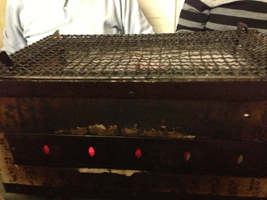
It’s Getting Hot in Here
What followed was supposed to be theoretically the better bottle, the 1985 Krug Collection . This was a recently released bottle, resting all these years until recently in the cellars. It was milky and yeasty with citrus and bread aromas. The palate had more wood but was flatter and surprisingly softer. There was more vanilla and perfume here, but it was less polished and vigorous than usual – was it bottle variation? Bipin found the Collection ‘more exotic,’ but everyone ultimately preferred the original. I think the Collections will age longer, but a lot depends on the date of disgorgement versus release, too (personally, I think ten years in the bottle is required after disgorgement before a bubbly becomes approachable again)(94?).
The first flight of wines had only one clue, ‘same producer.’ The first of that flight had sweet fruit with carob and caramel aromas in its nutty nose. There was a drop of honey adding complexity, with lots of meat, make that smoked beef, then again we were at Totoraku’s (his specialty). The palate was round, rich and luscious with creamy and hidden acidity. It lingered well and was in a great spot. We settled on Cali thanks to some rich coffee flavors, and indeed, it was a 1974 Heitz Martha’s Vineyard (94+).
The second wine was corked, more so in the nose but not so much on the palate. There was a sweeter, riper palate here with almost some tropicality. It had nice thickness and was more open with the most mature fruit, in a gamy and fleshy way. This was the 1970 Heitz Martha’s Vineyard (93A).
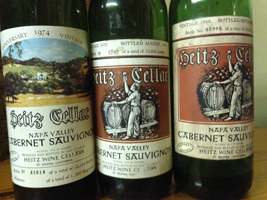
Classic Cali
The last in this flight was the best. Originally, I thought it was the ’74, but it turned out to be 1969 Heitz Martha’s Vineyard. This was that classic, minty, style of great, old Heitz. Its nose was super sexy, so chocolaty and creamy with that hint of eucalyptus. This was delicious with charcoal and chocolate flavors and leather to its length. There was only one way to sum this wine up, ‘Cheers to a great wine and an even better position’ (95).
The clue for the next flight was ‘three decades.’ The first wine had classic Bordeaux aromas of chocolate, cedar, cassis and pencil. Secondary wafer, honey, cream and bread aromas joined the party. Its palate was rich, sensual, creamy and long. The 1989 Palmer’s flavors were similarly classic, unfolding on its youthful, dark finish (95+).
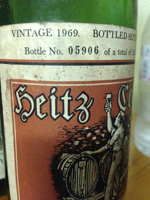
You Know You Like That
The second wine was a lot more moldy in its nose with some garden there but more must than anything else. There were flavors of dust, olive and honey in this smooth, balanced and long 1970 Palmer (94).
The third wine in this flight took immediate charge. There was more chocolate and cream here, and Bipin noted, ‘rhubarb and celery.’ I was feeling the red citrus thing as well, and this was clearly an older wine, smooth and satiny in the mouth. There were library and tree flavors supporting its flesh, fruit and cream. It kept getting better and better in the glass, a tribute to the quality of the vintage, which happened to be arguably the greatest vintage of all-time. It was a 1945 Palmer (97).
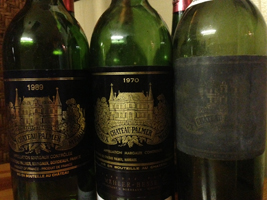
Three Decades
Same producer’ was our next clue for this flight of four. The first had rye and caraway aromas in its clean and classy nose. Cedar and spice lightly frolicked around. This was a smooth, soft and easy wine, simpler in a way but solid. Bipin admired its ‘leather.’ It was a 1995 La Mission Haut Brion, although the X-Man later confessed it was supposed to be a 1955 but an error was made pulling the wine. No comment J (92).
There was a Pomerol kink to the second La Mission, leading a guest or two in the Lafleur direction. If there ever were an overripe, Pomerol impostor of a La Miss, it would certainly be the 1989 La Mission Haut Brion. This was an open and plummy wine with lots of iron, musk, wheat and cedar. Rich and long, its fleshy and plummy flavors lingered regally. Great stuff (97+).
The next wine had similar characteristics in its nose in that kinky and gamy direction. There was more chocolate here, along with tasty, smooth flavors that were more balanced and distinguished. This was classic 1982 La Mission Haut Brion. Tasty and gorgeous, it knew how to both enter and exit the room (96).
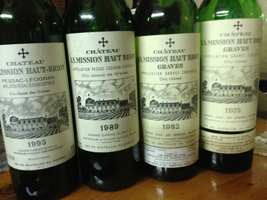
Johnny Johnny Johnny Oops!
The 1975 La Mission Haut Brion brought more plums to the party, along with more honey. Its nose was quite open with vanilla soda aromas, and its palate was lush and creamy, but it was definitely in third place. I have recently found this vintage on more than one occasion to be maturing and not as thrilling as it was a few years back. That being said, it was still outstanding (95).
The last flight had the same clue with a twist, ‘Always Last.’ I was thinking DRC, but the flight referred to Burgundy in general. The X-Man feels that Burgundy should always be served after Bordeaux, even though many do the opposite. I can’t argue with him. The first had a gorgeous nose, made all the more gorgeous by the fact that it was something new. There was great fruit, nut and smoke aromas, along with some what I called ‘good pig,’ and a touch of sake and soy with green pitch. There was lovely lushness and a nutty kick to this edgy Burgundy, and a touch of lemony spritz on the finish of the 1961 Comte de Vogue Bonnes Mares (94).
The second Burgundy had aromas of tobacco and hot sauce, and then the tomato ensued. This was tomato in all of its stages and splendor, showing different hues and even some sun-dried qualities. The palate was rich and gamy, showing more tomato and morphing into Bloody Mary city. The 1966 Comte de Vogue Musigny V.V. was a long and fleshy wine, gaining in the glass over time (95+).
The final wine on this most memorable night was a 1962 Comte de Vogue Musigny V.V. that was a touch oxidized, but still clearly the wine of the flight. The layers to its flesh, its game and its good stink all added up into what would have been a stunner of a wine. I didn’t write much more at this point, other than, ‘should have been wine of flight, still might be even though affected’ (96A).
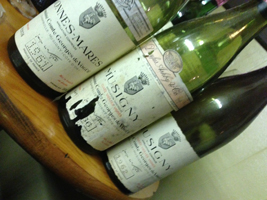
Always Last
As the night drew to a close, and all of Bipin’s merry men cheerfully slipped into the night, he gave me a look and a smile, and without saying without a word, told me, ‘This is how we still do it.’
You can always count me in for a dinner with Bipin.
In Vino Veritas,
JK
